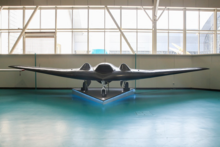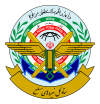Shahed 171 Simorgh
| Shahed 171 Simorgh | |
|---|---|

| |
| Role | Multirole[1] |
| National origin | Iran |
| Manufacturer | Shahed Aviation Industries |
| First flight | 2014[2] |
| Status | Active |
| Primary user | IRGC AF |
| Produced | 2010s–present |
| Developed from | RQ-170 Sentinel |
The Shahed 171 Simorgh (sometimes S-171 and called IRN-170 by the US government[1]) is an Iranian jet-powered flying wing unmanned combat aerial vehicle (UCAV) produced by Shahed Aviation Industries.[3]
Its design is based on a reverse engineered American RQ-170 UAV captured by Iran in 2011 and modified to carry guided missiles.[3] It is one of two Iranian flying wing UAVs based on the RQ-170, along with the Saegheh, a smaller version, with which it is often confused.
Etymology[edit]
Simorgh is a Persian word deriving from Middle Persian 𐭮𐭩𐭭𐭬𐭥𐭫𐭥 sēnmurw,[4][5] which was a benevolent bird in Persian mythology.
Design[edit]
The Simorgh is a reverse engineered RQ-170. There are multiple unknown variants, one of which is modified to play the role of a UCAV armed with 4 missiles. An author stated it was a crude mock-up mostly made out of fiberglass.[6][7] It was used with munitions during the 2020 Joint Exercise Zolfaghar 99.[8]
Status[edit]

According to the United States Government, a company associated with Imam Hossein University, Paravar Pars Company, was involved in the reverse engineering and research, development, and production of the Shahed 171.[9]
Two were under construction as of 2014.[10] In 2014 Iran said that they would have four in service by March 2015.[11]
The UAV was first seen in May 2015 and was shown flying on Iranian TV in October 2016.[12] Jane's analysis placed the UAV at Kashan Air Base.[12][13]
Some sources report that a Shahed 171 may have been shot down in the February 2018 Israel–Syria incident, but the UAV was probably the very similar Saegheh.[3]
Operators[edit]
See also[edit]
Related development[edit]
Aircraft of comparable role, configuration and era[edit]
References[edit]
- ^ a b Iran Military Power (PDF). Defense Intelligence Agency. 2019. p. 68. ISBN 978-0-16-095157-2.
- ^ Opall-Rome, Barbara (13 February 2018). "Israel Air Force says seized Iranian drone is a knockoff of US Sentinel".
- ^ a b c "Sentinels, Saeqehs and Simorghs: An Open Source Survey of Iran's New Drone in Syria". bellingcat. 13 February 2018.
- ^ A. Jeroussalimskaja, "Soieries sassanides", in Splendeur des sassanides: l'empire perse entre Rome et la Chine (Brussels, 1993) 114, 117–118, points out that the spelling senmurv, is incorrect as noted by David Jacoby, "Silk Economics and Cross-Cultural Artistic Interaction: Byzantium, the Muslim World, and the Christian West", Dumbarton Oaks Papers 58 (2004): 197–240, esp. 212 note 82.
- ^ Schmidt, Hanns-Peter (2002). Simorgh in Encyclopedia Iranica.
- ^ "Iranian Copy of U.S. Unmanned Stealth Aircraft is a Fake - USNI News". 12 May 2014.
- ^ "Farsnews". en.farsnews.com. Archived from the original on 2019-08-24. Retrieved 2018-11-21.
- ^ Hanna, Andrew (14 September 2020), "Iran Tests Weapons During War Game", The Iran Primer, United States Institute of Peace
- ^ "Treasury Sanctions Iranian Persons Involved in Production of Unmanned Aerial Vehicles and Weapon Shipment to Russia". September 8, 2022.
- ^ http://www.farsnews.com/newstext.php?nn=13930222001585 Archived 2015-10-04 at the Wayback Machine (May 2014) (translation here)
- ^ "Farsnews". en.farsnews.com.
- ^ a b "Iranian 'stealth' UAV test site identified - IHS Jane's 360". 8 October 2016. Archived from the original on 8 October 2016.
- ^ "Iran's Simorgh Test Site Identified". Offiziere.ch. 8 October 2016. Archived from the original on 21 October 2018. Retrieved 17 May 2019.

